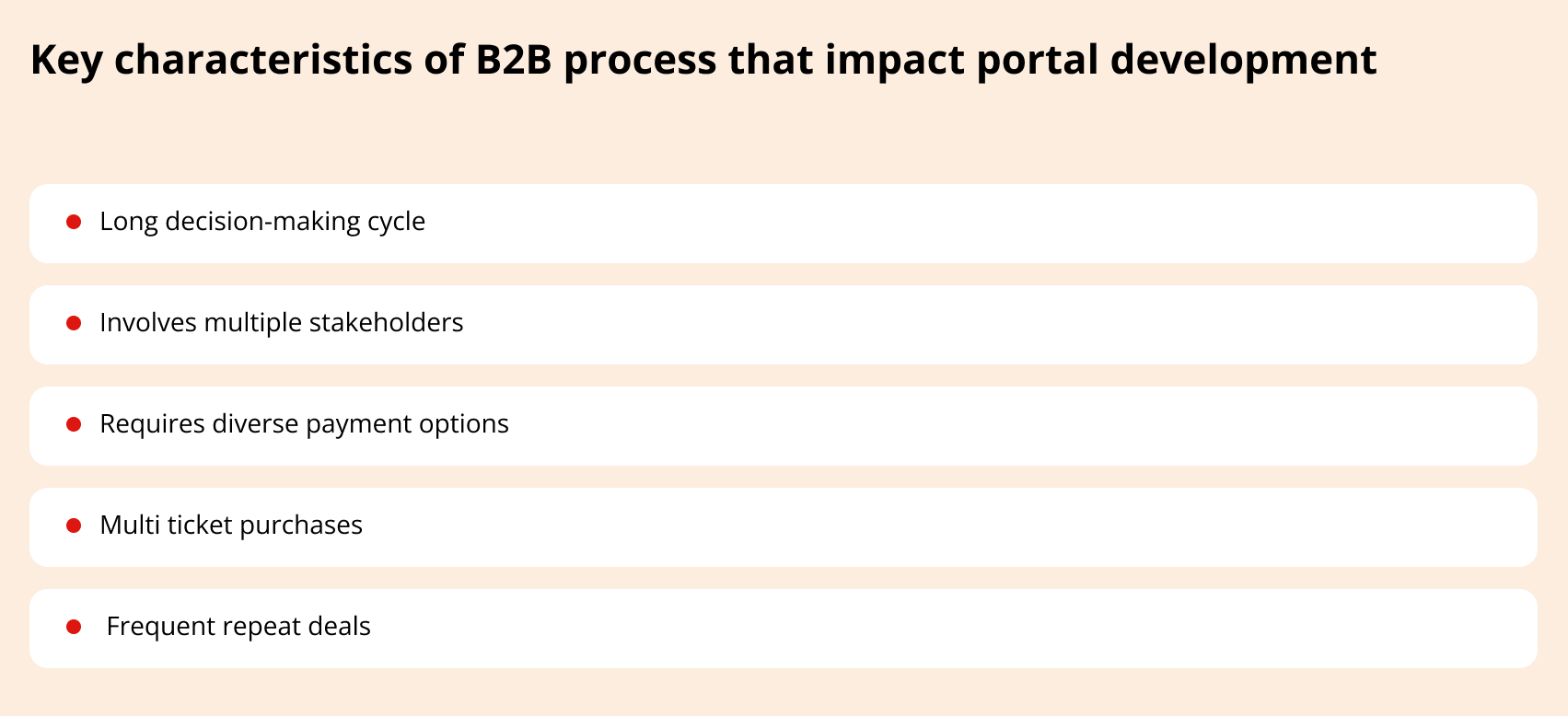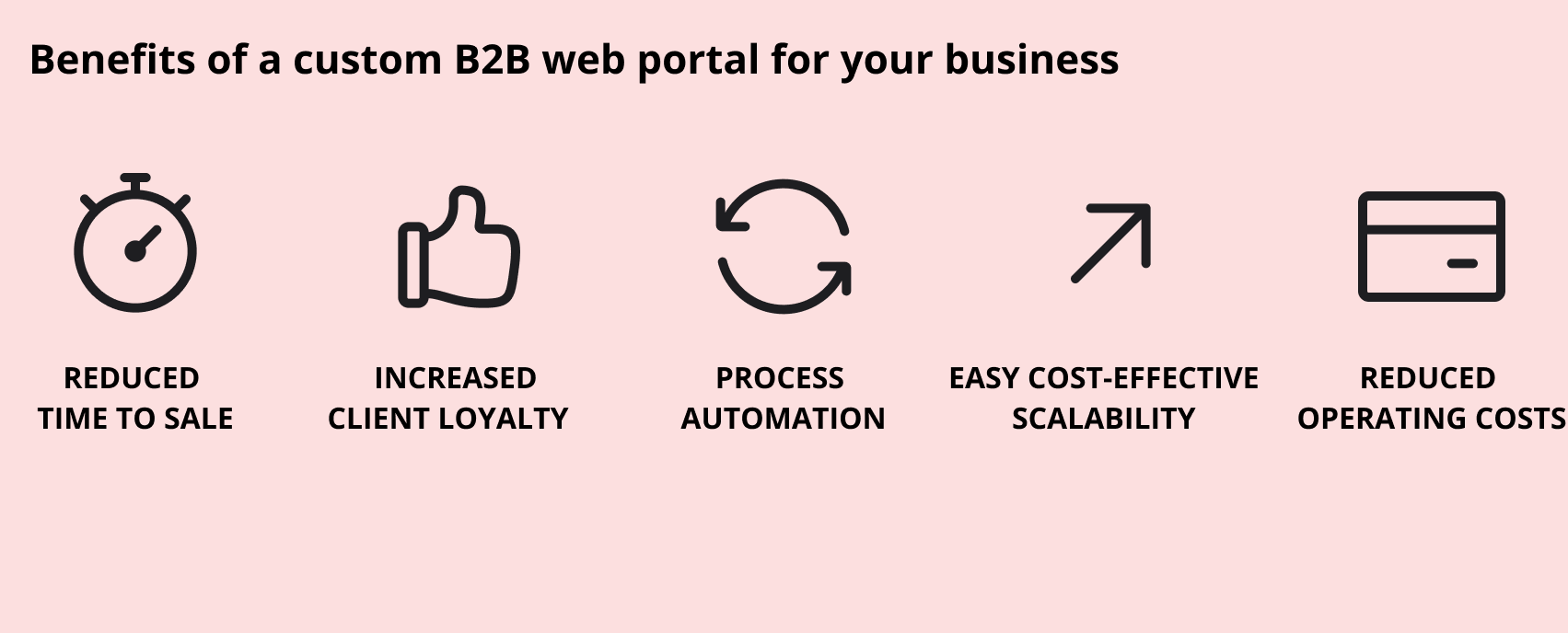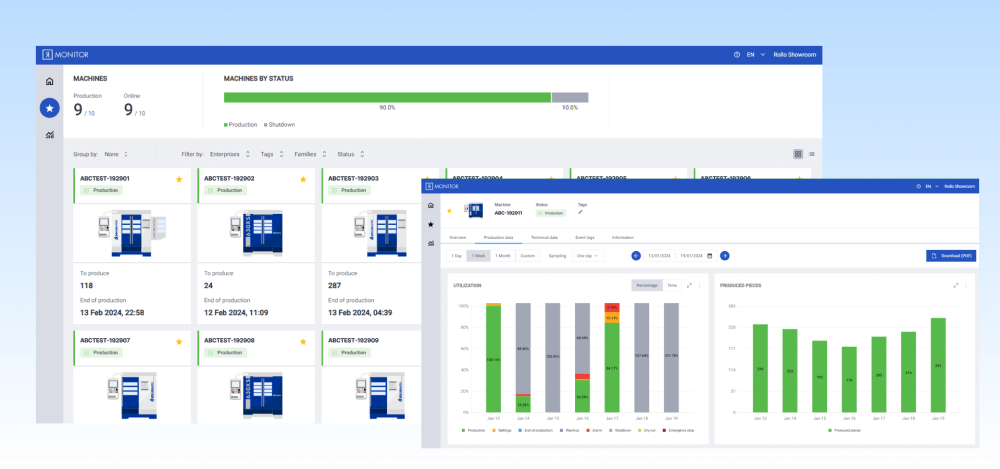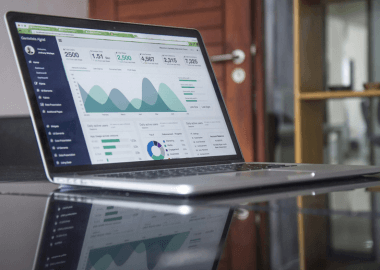Complete Guide to Custom B2B Web Portal Development
B2B web portal development is not just for big brands anymore. Two-thirds of B2B companies already sell their products and services fully online. As a revenue stream, it beats nearly all other channels and ties with in-person sales, encouraging all B2B companies to up their investment in web portal engineering.
To stay competitive and meet buyers where they are, you need to provide them with an online space where they can interact with your brand and complete transaction. If you don’t have a portal yet, this guide is your starting point to get one. Here we talk about:
- How to tailor a web portal to the specifics of B2B space
- What features to consider to make sure your clients and partners will stick to your portal
- What benefits you will reap from integrating a quality portal into your process
- How to develop B2B web portal in 4 time-tested steps
- How much it will cost to build a fully-fledged portal
But first, let’s quickly walk through the specifics of web portals and see how they fit in B2B workflows.
B2B web portal is a one-stop online space where your clients, vendors, or partners can easily access products, services and content and make transactions. Depending on your goals, you can use it as a marketplace, sales engine, or collaboration platform. The best bit? Your portal can address the exact needs and demands of your audience, giving you an invaluable competitive advantage.
Just like customers in B2C, modern B2B buyers want to be able to do their research and carry out transactions on their own. Portals provide them with web tools available around the clock to do that, and a lot more.
B2B buyers spend 27% of time in the buying process doing independent online research before considering a purchase.
Unlike B2C space, however, business-to-business operations are way more complex and lengthy.

How web portals fit in the B2B workflows
- Long and complex B2B buying process. B2B decision-making cycles differ greatly depending on the industry. It can be as short as a few days in retail and take months or even years for global transactions in energy. B2B portals should be able to support buyers across their journey, no matter how long and complex it is.
- Multiple stakeholders in decision-making. There are 6 to 10 people involved in the B2B decision-making process. Therefore, most portals should feature roles, access rights, and personalized content for different stakeholders.
- Shifting buyer behavior and rise of self-service features. Changes in buyer behavior and the growing popularity of self-service tools affect sales cycles in B2B. Buyers prefer to “buy on their own terms and timelines,” writes Forrester’s Principal Analyst, Rick Bradberry. Web portals help business adapt to this shift to keep sales strong and make buying easy.
- Flexible payment methods and high-value deals. Businesses use various types of transactions and payment methods to close deals. Moreover, the average value of online purchases has grown significantly in the last couple of years, according to McKinsey B2B Pulse. The share of companies that are willing to close $500k-$1mln+ deals using digital channels is historically high (35%). In other words, a web portal is no longer a place for small-ticket purchases only, and therefore requires adequate tools for flexible, secure, and effective transactions.
These specifics impact the scope of B2B portal development and point to the features you might want to consider to fit the needs of your clients.
The functionality of your portal will depend on many factors, such as your niche, audience, priorities, and existing infrastructure. There are, however, several features that are common for almost all types of web portals in B2B: marketplaces or B2B eCommerce platforms, partner and vendor management platform development.

1. Secure authorization and account set-up
Business account and secure authorization features set a client-centric portal apart from an all-purpose website. These features are essential to identify users and provide them with unique offers, pricing, and services.
2. Roles and access management
We already mentioned that multiple stakeholders are involved in the B2B decision-making process. Roles and distribution of rights make it simple and secure for different people throughout the organization to access necessary information. As a result, it speeds up the entire process and improves buyer experience.
3. Product and service order workflow
Product and service lists along with a set of self-service features (order, payment, tracking, billing, one-click reorder) simplify and speed up the purchase journey. Add smart search, recommendation algorithms, and personalization features to tailor buyers’ experience to their unique needs and you get yourself an ultimate sales engine.
4. Payment and credit tools
Invoicing, payment, and credit tools are essential features for developing a custom web portal for B2B transactions. They provide flexibility and give buyers levers for effective purchase strategies online. For many B2B companies, implementing this functionality means integration with the platforms they already use for these tasks.
5. System integrations
A B2B web portal rarely exists in isolation. As part of B2B operations, it is often integrated with various business systems already in use in the organization, such as CRM, ERP, document management systems, etc. It enables secure data transfer and helps gather scattered experiences across different channels.
And the benefits only start here.

Increase client satisfaction and loyalty
Clients are loyal to the companies that deliver the best experience. A B2B web portal has tools to create this experience – personalize offers, provide easy navigation and quick access to products and services, and create a seamless buyer journey from search to order to one-click reorder. All this helps you build lasting engagement with your clients and nurture loyalty.
Reduce sales cycle and speed up purchase
Provide your clients with self-service web tools to speed up and simplify the purchase process: web demos and catalogs, A-to-Z order management tools, dashboards with instant insights, etc. Or create the entire workflow online for simple B2B transactions. Either way, you slash the length of your sales cycle and close more deals in less time.
Cut costs and automate workflows
Every B2B process is unique and has different potential for automation. This is why when planning on how to create web portal for B2B operations, start with identifying inefficiencies in a current process and steps that would benefit from business automation. Then see how web technologies can help you fix that – get rid of spreadsheets, paperwork, calls, manual invoices, human errors, etc. Depending on the complexity of operations, automation can save you 10%-50% of business costs.
Expand client acquisition
Want clients and partners to come to you? Set up an online space where they can find what they need and hit their goals faster. A B2B portal helps you reach your audience on a wider scale without hiring more sales reps and opening new branches in new locations.
Scale easily without overhead costs
About new branches. Another huge benefit of integrating a custom web portal for B2B operations is easy scalability. With the right content management tools and integrations in place, you can expand your offers, services, geo, data sources, or supplier base fast and cost-effectively.
Gain visibility and transparency
A web portal allows you to integrate multiple experiences and business systems in one place. You get a 360-degree view of your B2B operations, client journeys, interactions, order statistics, and more. So that you could create an insight-driven strategy for your business and improve supply chain management.
Give clients self-service tools before your competitors do
Create a frictionless experience for every step of your client journey, then watch your revenue grow.
Portal development servicesWe covered the role and benefits of web portals in B2B and how to adjust them to the specifics of your business-to-business interaction. Next, we’ll walk you through the process of web portal development and show how to develop custom web portal for B2B with a laser focus on your clients’ needs and expectations.
B2B web portal development is not much different from an industry-standard approach to software development. It consists of research, design, development, support and maintenance. In addition to that, it included several crucial steps that help the tech team design and build a system that will smoothly integrate into your infrastructure without disrupting your process and operations.

Step 1. Research and planning
When we talk about how to make B2B web portal tailored to the needs of a particular business, we always mention Discovery as the best way to start. Discovery is a research stage that includes an in-depth analysis of all key aspects of the project – requirements, audience, market, competition, industry-specific technologies, business opportunities, and limitations. Deliverables include documented and prioritized project requirements, detailed time and cost estimate, and project roadmap.
But not every project has to start with Discovery. If you already have clear requirements and project goals, you can kick off with a shorter but no less valuable scoping workshop. By the end of the research phase, you should have a clear vision of the future system and a detailed plan for its implementation.
NOTE: Technology analysis is an important part of the research phase during B2B portal development. It includes the analysis of the existing tech stack and infrastructure, business systems, APIs, integrations, and third-party platforms that will connect with your portal. Decisions made at this step will affect the system’s scalability, security, and overall performance.
Step 2. Ideation and UX/UI design
Ideation and design is a collaborative phase. During this phase, designers use the results of the research along with all the information they can get from the stakeholders (branding, style book, marketing requirements) to create an effective user experience and interface for the future web system. Iteration by iteration, sketches turn into wireframes, and then into a clickable prototype that demonstrates user journeys across the entire B2B portal.
Step 3. Development and testing
Development and testing is the longest phase of B2B web portal development. It consists of a series of iterations, each two to four weeks long depending on the scope. Developers build system components and responsive user interface, migrate data, set up APIs and web portal integrations with in-house systems and third-party components, test and deploy using modern engineering practices (CI/CD, unit tests, test automation, etc.).
Step 4. Deployment and ongoing support
The first functional version of the system is out. As your clients and partners start using your portal, you get performance and usage data and see how to further optimize and scale your system. Client feedback and real-world data is the valuable source of insights that show how to create B2B web portal tailored to immediate and changing user needs.
The cost of custom B2B web portal varies wildly depending on the scope, tech stack, integrations, team composition, and delivery goals.
To give you a general idea, we provide an example estimate for a market-ready B2B web portal with the following features:
- Login and sign-up
- User account and dashboard
- List of services and selection
- Online order
- View order status
- Order history
- Online payment
- Integration with order management system
- CMS and admin dashboard for content and order management
- Integrations with third-party services (support chat, payment gateway, etc.)
| Phase | Time (hours) |
|---|---|
| Design | – |
| UX prototype | 46 |
| UI kit | 46 |
| Design system | 16 |
| General | – |
| Architecture | 24 |
| Data model | 24 |
| Development | – |
| Login/sign-up | 56 |
| User account | 56 |
| User dashboard | 96 |
| List of services and selection | 64 |
| Order service | 80 |
| Order status | 56 |
| Integration with payment | 72 |
| Integration with chat | 48 |
| CMS and info pages | 80 |
| Integration with OMS | 64 |
| QA and debugging | 224 |
| Project management | 224 |
| Total | 1276 |
The total cost of the project will depend, among other things, on whether you hire an in-house web development team or outsource. For instance, based on the average hourly rates of UX/UI designers, frontend, backend, and QA engineers in the US (source: Indeed, 2025), the total cost of this B2B portal project would start at around $103k.
Outsourcing to a reliable service provider would cut the cost of web portal development by up to 30% without dropping the quality of the end product. And all because of lower hourly rates in popular outsourcing destinations (Central Europe, South America).
To get a detailed estimate for your B2B web portal development, contact our team. We will set up a discovery call, analyze your requirements, expectations, and digital transformation goals, conduct the research, and make an estimate for your project.
Looking for a reliable tech partner with a solid track record in B2B portal development? We can help. Our team has been developing value-driven products for B2B brands since 2010. You can leverage our expertise and tech skills to automate workflows, enhance client experience, and add self-service tools to your process.
- 15+ years in web development for mid-size and enterprise B2B brands.
- Cross-functional teams and future-proof tech stack: .NET, Java, Angular, React, Python, Node.js, AWS, Google Cloud, Microsoft Azure, etc.
- Dozens of delivered web projects for Oxford University Press, Printique, Origin Digital, Lodgify, Diaceutics, Kantar, etc.
- ISO-certified process (ISO 27001, ISO 13485, ISO 9001), compliant data practices, and guaranteed quality of deliveries.
- Strong industry expertise in logistics, education, healthcare, agriculture, retail, energy, manufacturing, and more.

Example: Modernization of a web portal helped a manufacturing company improve client experience with quick secure access to monitoring orders and machine performance.
Need help with B2B web portal development?
We will design and develop a user-centered portal and seamlessly integrate it into your process without draining your resources and time.
Hire web portal developersQuick round-up
- In this guide to B2B web portal development, we talked about the role and benefits of web portals in the B2B space and shared a step-by-step framework for web portal development.
- Integrating a web portal into operations provides multiple benefits for B2B brands and their clients: boosts loyalty, helps companies cut sales cycle and business expenses, and opens the doors to new opportunities and markets.
Not sure if you need a custom portal or a ready-made product? Check our guide on the benefits of custom software and how to choose the right approach that addresses your business goals and resources.
This post was originally published on November 4, 2022 and updated on February 26, 2025.







